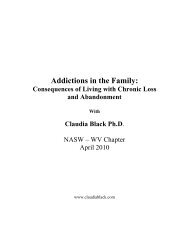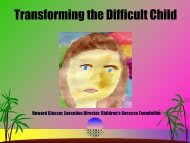Psychodynamic Theory and Treatment of Depression
Psychodynamic Theory and Treatment of Depression
Psychodynamic Theory and Treatment of Depression
You also want an ePaper? Increase the reach of your titles
YUMPU automatically turns print PDFs into web optimized ePapers that Google loves.
<strong>Psychodynamic</strong><strong>Theory</strong> <strong>and</strong><strong>Treatment</strong> <strong>of</strong>Clinical<strong>Depression</strong>Eric D. Rankin, Ph.D.,Pr<strong>of</strong>essor
Fundamental Concepts in <strong>Psychodynamic</strong> Therapy.• Inner psychic world <strong>and</strong> outer reality.– Development <strong>of</strong> the self begins with the ability to discern “me” fromthe “not me”.– Our “inner world” is populated with thoughts, fantasies, emotions <strong>and</strong>object relations which are related to but distinct from the “outerworld”.• Consciousness <strong>and</strong> Unconsciousness.– We are conscious <strong>of</strong> only a small portion <strong>of</strong> the inhabitants <strong>of</strong> ourpsychic inner-world.– Nevertheless, the unconscious aspects <strong>of</strong> our mind exert a tremendousinfluence over our conscious thoughts, emotions <strong>and</strong> behavior.• Use <strong>of</strong> clinical material: Permission, Disguised.
<strong>Psychodynamic</strong> Factors Contributing to MDD.
<strong>Psychodynamic</strong> Factors Contributing to MDD.• Narcissistic Vulnerability.– Early experiences or perceptions <strong>of</strong> loss, rejection, <strong>and</strong>/or inadequacyinteract with possible biochemical vulnerability resulting in asensitivity toward perceived or actual losses/rejections.– This, in turn, triggers depressive affects <strong>and</strong> a recurrent lowering <strong>of</strong>self esteem.
<strong>Psychodynamic</strong> Factors Contributing to MDD.• Conflicted Anger Towards Others.– Anger results as a response to narcissistic injury which in turndisrupts interpersonal relationships resulting in a further lowering <strong>of</strong>self esteem <strong>and</strong> depressive affects.
Central <strong>Psychodynamic</strong> Models <strong>of</strong> <strong>Depression</strong>.• Severe Superego: Experience <strong>of</strong> Guilt <strong>and</strong> Shame.– The Superego comprises the moral functions <strong>of</strong> the person.– These include:1. The approval or disapproval <strong>of</strong> actions <strong>and</strong> wishes--the grounds <strong>of</strong>morality,2. Critical self-observation,3. Self-punishment,4. The dem<strong>and</strong> for reparation or repentance <strong>of</strong> wrongdoing, <strong>and</strong>5. Self-praise or self-love as a reward for virtuous or desirable thoughts<strong>and</strong> actions (ego ideal).
Central <strong>Psychodynamic</strong> Models <strong>of</strong> <strong>Depression</strong>.• Severe Superego: Experience <strong>of</strong> Guilt <strong>and</strong> Shame.– Parental images which form the initial structure <strong>of</strong> the superego arethose <strong>of</strong> the parent’s superegos as experienced by the young child.These early introjects tend to be concrete <strong>and</strong> remain unconscious(excluded from further reality testing <strong>and</strong> maturation) <strong>and</strong> areexemplified by:• Talion Law: “An eye for an eye”.• Lack discrimination between wish <strong>and</strong> deed.
<strong>Psychodynamic</strong> Factors Contributing to MDD.• Idealized <strong>and</strong> Devalued Expectations <strong>of</strong> Self, Others.– In an effort to mitigate low self esteem, a person may ascribeexcessively high expectations <strong>of</strong> self or idealization <strong>of</strong> others resultingin significant disappointment, anger at self or others <strong>and</strong> a furtherlowering <strong>of</strong> self esteem.– In some instances, significant others are not idealized but devalued tobolster self esteem resulting in a disruption in these primaryrelationships <strong>and</strong> a lowering <strong>of</strong> self esteem which, in turn, triggersdepressive affects.
<strong>Psychodynamic</strong> Factors Contributing to MDD.• Characteristic Means <strong>of</strong> Defending Against Painful Affects(defense mechanisms)– Ego Defense Mechanisms: Are the ego’s response to anxiety resultingfrom when the id impulses (libidinal, aggressive) are in conflict witheach other, when the id impulses conflict with super-ego values <strong>and</strong>beliefs, <strong>and</strong> when an external threat is posed to the ego.– Ego Defense Mechanisms are at least somewhat unconscious(depending upon their level <strong>of</strong> reality testing).– Primitive defense mechanism (e.g., denial, projection, passiveaggression,reaction formations) are overly relied upon in an effort tomitigate intolerable negative feelings. As a result, negative affects arenot effectively dealt with but remain split <strong>of</strong>f <strong>and</strong> repressed capable <strong>of</strong>continuing to exert an influence unconsciously.
Distinctive Features <strong>of</strong> <strong>Psychodynamic</strong> Therapy.• Focus on affect <strong>and</strong> expression <strong>of</strong> emotion.– The therapist helps patients describe <strong>and</strong> put words to feelings,including contradictory feelings, feelings that are troubling orthreatening <strong>and</strong> feelings that the patient may not initially be able torecognize or acknowledge (in contrast with CBT where the greateremphasis is on thoughts <strong>and</strong> beliefs).
Distinctive Features <strong>of</strong> <strong>Psychodynamic</strong> Therapy.• Exploration <strong>of</strong> attempts to avoid distressing thoughts <strong>and</strong>feelings.– <strong>Psychodynamic</strong> therapists actively focus on <strong>and</strong> explore avoidanceswhether they occur within sessions (shifts in topics, attending to facts<strong>and</strong> events to the exclusion <strong>of</strong> affect, etc) or outside <strong>of</strong> session (missedappointments, etc).– Psychic Determinism: in the mind, nothing happens by chance or in ar<strong>and</strong>om way; each psychic event is determined by the ones thatpreceded it.
Distinctive Features <strong>of</strong> <strong>Psychodynamic</strong> Therapy.• Identification <strong>of</strong> recurring themes <strong>and</strong> patterns.– <strong>Psychodynamic</strong> therapists work to identify <strong>and</strong> explore recurringthemes <strong>and</strong> patterns in patient’s thoughts, feelings, self concept,relationships <strong>and</strong> life experiences.– In some cases, patients may be acutely aware that these patterns arepainful or self-defeating but feel unable to escape them. In other cases,they may be unaware <strong>of</strong> them until the therapist helps him or herrecognize <strong>and</strong> underst<strong>and</strong> them.
Distinctive Features <strong>of</strong> <strong>Psychodynamic</strong> Therapy.• Discussion <strong>of</strong> past experience (developmental focus).– <strong>Psychodynamic</strong> therapy recognizes that past experiences, especiallyearly experiences with attachment figures affects our relation to <strong>and</strong>experience <strong>of</strong>, the present.– The focus is not on the past for its own sake but rather on how the pastsheds light on current psychological difficulties with the goal being tohelp patients free themselves from the bonds <strong>of</strong> past experience inorder to live more fully in the present.
Distinctive Features <strong>of</strong> <strong>Psychodynamic</strong> Therapy.• Focus on interpersonal relations.– <strong>Psychodynamic</strong> therapy places heavy emphasis on relationships <strong>and</strong>interpersonal experience (object relations, attachment).– Adaptive <strong>and</strong> maladaptive aspects <strong>of</strong> personality <strong>and</strong> self concept areforged in the context <strong>of</strong> attachment relationships.– “The baby finds itself in the eyes <strong>of</strong> its mother” D. W. Winnicott
Distinctive Features <strong>of</strong> <strong>Psychodynamic</strong> Therapy.• Focus on the therapy relationship.– Transference is ubiquitous. It is a fundamental part <strong>of</strong> all humanrelationships. Psychoanalytic therapies do not create the transference;they discover it <strong>and</strong> make it visible (conscious).– The reoccurrence <strong>of</strong> interpersonal themes in the therapy relationship(transference, counter transference) provides a unique opportunity toexplore <strong>and</strong> rework them in vivo.– Thus transference repeats development.
Distinctive Features <strong>of</strong> <strong>Psychodynamic</strong> Therapy.• Exploration <strong>of</strong> fantasy life.– <strong>Psychodynamic</strong> therapists encourage patients to speak freely aboutwhatever is on their mind (free associate) including their daydreams,fantasies <strong>and</strong> dreams.– The goal is to underst<strong>and</strong> not only the significance <strong>of</strong> the content to thepatient but the processes by which the material is brought to thesurface <strong>and</strong> how it is h<strong>and</strong>led by the patient thereby <strong>of</strong>fering greaterinsight into the workings <strong>of</strong> their mind.
Distinctive Features <strong>of</strong> <strong>Psychodynamic</strong> Therapy.• Goal <strong>of</strong> psychodynamic psychotherapy.– Includes but extends beyond symptom remission. Successful treatmentshould not only relieve symptoms but also foster the positive presence<strong>of</strong> psychological capacities <strong>and</strong> resources.• More fulfilling relationships.• More effective use <strong>of</strong> one’s talents.• Ability to tolerate a wider range <strong>of</strong> affects.• A more nuanced <strong>and</strong> sophisticated underst<strong>and</strong>ing <strong>of</strong> self <strong>and</strong>others.
<strong>Psychodynamic</strong> <strong>Treatment</strong> <strong>of</strong> <strong>Depression</strong>.• Indications for psychodynamic psychotherapy.1. Motivation to underst<strong>and</strong> the sources <strong>of</strong> symptoms (“psychologicallyminded”).2. Capacity to think about meaningful <strong>and</strong> complex relationships withothers.3. Capacity for control over impulses.4. Ability to underst<strong>and</strong> metaphors (e.g., “inner – outer rooms”).5. Capacity to acknowledge emotional states.6. Good reality testing.
<strong>Psychodynamic</strong> <strong>Treatment</strong> <strong>of</strong> <strong>Depression</strong>.• Contra-Indications for psychodynamic psychotherapy.1. Marked difficulty observing the self or reflecting on others’ motivations.2. Significant inability to tolerate frustration.3. Globally impaired relationships.4. Marked difficulty forming an alliance with the therapist.5. Low intelligence.6. Severe depression that disrupts the patient’s ability to work effectively.
<strong>Psychodynamic</strong> Assessment <strong>of</strong> <strong>Depression</strong>.• Assessment <strong>of</strong> clinical symptoms.– DSM-IV criteria.• While DSM criteria are important, a diagnosis should not simplybe based on the patient’s presenting problem <strong>and</strong> clinicalsymptoms.• The therapist needs to consider the context in which the complaintis made <strong>and</strong> in which the symptoms occur because the underlyingconflicts will differ from patient to patient while symptoms maynot.• Similarly in practice, the nature <strong>of</strong> the transference relationship is<strong>of</strong>ten more important than the original diagnosis because astherapy progresses one is always dealing with the person behindthe symptoms.
<strong>Psychodynamic</strong> Assessment <strong>of</strong> <strong>Depression</strong>.• Developmental <strong>and</strong> family history.1. Patient’s perceived ability <strong>of</strong> the family to respond to their childhoodemotions, especially negative feelings (e.g., sadness, shame, anger)<strong>and</strong> events (e.g., losses, illnesses, separations).2. Childhood depressive symptoms.3. Perceptions <strong>of</strong> parental attitudes <strong>and</strong> behaviors.4. Characteristics <strong>and</strong> qualities <strong>of</strong> their adult relationships (e.g.,conflicts, emotional themes, perceived level <strong>of</strong> responsiveness <strong>of</strong>significant others).5. Family history <strong>of</strong> depressive disorders <strong>and</strong> attitudes towards thishistory.
<strong>Psychodynamic</strong> <strong>Treatment</strong> <strong>of</strong> <strong>Depression</strong>.• Initial phase <strong>of</strong> treatment.– Establishing a therapeutic frame.• Includes frequency <strong>of</strong> sessions, expectations for clinical material, etc.– Establishing a therapeutic alliance.• Conveying a sense <strong>of</strong> interest <strong>and</strong> an ability/willingness to underst<strong>and</strong>• Developing a consensus <strong>and</strong> working relationship, etc.– Clarifying the central depressive dynamics.• Narcissistic vulnerability, conflicted anger, severe superego, etc.
<strong>Psychodynamic</strong> <strong>Treatment</strong> <strong>of</strong> <strong>Depression</strong>.• Middle phase <strong>of</strong> treatment.Techniques used in the middle phase.a. Clarification.b. Confrontation.c. Interpretation: defense,genetic, dynamic.d. Interpretation <strong>of</strong> dreams,parapraxes, etc.e. Interpretation <strong>of</strong> thetransference <strong>and</strong> attentionpaid to the countertransference.Surface InterventionsDepth Interventions
<strong>Psychodynamic</strong> <strong>Treatment</strong> <strong>of</strong> <strong>Depression</strong>.• Middle phase <strong>of</strong> treatment: Working through.Working Through<strong>of</strong> the…Defenses.Dynamics/conflicts.Transferences.Surface InterventionsTherapeutic AllianceDepth InterventionsRegression (in/out <strong>of</strong> <strong>of</strong>fice events) –stressors, empathic breeches.
<strong>Psychodynamic</strong> <strong>Treatment</strong> <strong>of</strong> <strong>Depression</strong>.• Termination phase <strong>of</strong> treatment.1. Factors to consider in deciding to terminate.a. Patient is less vulnerable to depression in the face <strong>of</strong> loss,disappointments, <strong>and</strong> criticism (i.e., narcissistic vulnerability).b. Patient can consistently better manage depressive feelings <strong>and</strong>aggression.c. Patient is consistently less prone to guilt <strong>and</strong> self-devaluation.d. Patient can consistently make more realistic assessments <strong>of</strong> ownbehavior <strong>and</strong> motivations <strong>and</strong> those <strong>of</strong> others.
<strong>Psychodynamic</strong> <strong>Treatment</strong> <strong>of</strong> <strong>Depression</strong>.• Issues associated with Termination <strong>of</strong> <strong>Treatment</strong>.1. Ending the work, relationship (i.e., actual, unresolved past grief).2. What to address in the remaining months.a. Setting a date vs. ‘graduated termination’b. Existential issues (e.g., what’s going to happen now?)3. Review the work, patient’s life themes <strong>and</strong> therapy – what helped youchange?4. Disappointment; expectation <strong>of</strong> the therapist, therapy that didn’t happen.5. The future – more therapy when it would be helpful; what type <strong>of</strong> contactwith the therapist after treatment.
<strong>Psychodynamic</strong> <strong>Theory</strong> <strong>and</strong> <strong>Treatment</strong> <strong>of</strong><strong>Depression</strong>: Summary• The existence <strong>of</strong> inner <strong>and</strong> outer psychic realities is part <strong>of</strong> thehuman experience.• The significant role <strong>of</strong> Consciousness <strong>and</strong> Unconsciousness in ourday-to-day lives.• <strong>Treatment</strong> Goals include Symptom Reduction/Resolution, but alsoimproved intra/interpersonal functioning <strong>and</strong> object relations.
<strong>Psychodynamic</strong> <strong>Theory</strong> <strong>and</strong> <strong>Treatment</strong> <strong>of</strong><strong>Depression</strong>: Summary (cont.)• Focus on the past to help underst<strong>and</strong> the present <strong>and</strong>psychologically free up the future.• The therapeutic focus is on relationships both in <strong>and</strong> out <strong>of</strong> thetherapeutic milieu with an emphasis on the patient/therapistrelationship.









